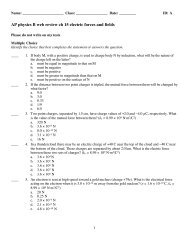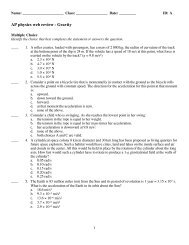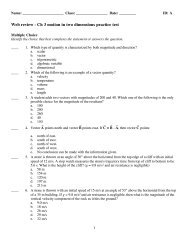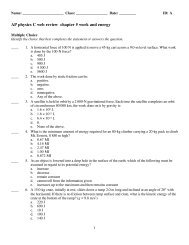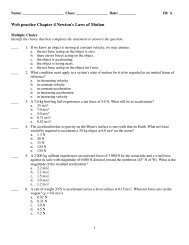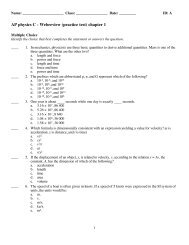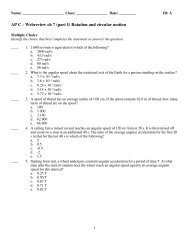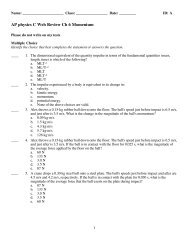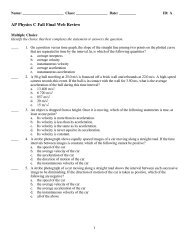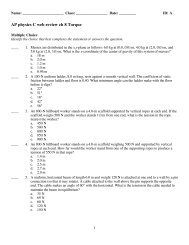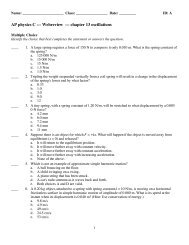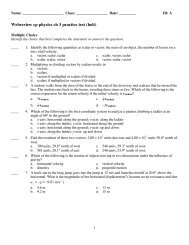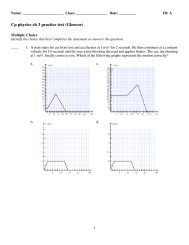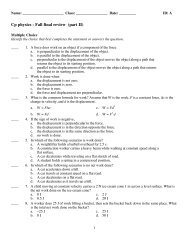Problem B Copyright reserved
nuclear decay 1 - Planet Holloway
nuclear decay 1 - Planet Holloway
- No tags were found...
Create successful ePaper yourself
Turn your PDF publications into a flip-book with our unique Google optimized e-Paper software.
NAME ______________________________________ DATE _______________ CLASS ____________________<br />
Subatomic Physics<br />
<strong>Problem</strong> B<br />
NUCLEAR DECAY<br />
PROBLEM<br />
SOLUTION<br />
The most stable radioactive nuclide known is tellurium-128. It was<br />
discovered in 1924, and its radioactivity was proven in 1968. This isotope<br />
undergoes two-step beta decay. Write the equations that correspond to<br />
this reaction.<br />
Given:<br />
Unknown:<br />
128<br />
52 Te → −1<br />
0 e + X + v <br />
X → −1<br />
0 e + Z + v <br />
the daughter elements X and Z<br />
The mass numbers and atomic numbers on both sides of the expression must be<br />
the same so that both charge and mass are conserved during the course of this<br />
particular decay reaction.<br />
Mass number of X = 128 − 0 = 128<br />
Atomic number of X = 52 − (−1) = 53<br />
The periodic table shows that the nucleus with an atomic number of 53 is iodine, I.<br />
Thus, the first step of the process is as follows:<br />
128<br />
52 Te → −1<br />
0 e +<br />
128<br />
53 I + v<br />
A similar approach for the second beta decay reaction gives the following equation.<br />
Again, the emission of an electron does not change the mass number of the<br />
nucleus. It does, however, change the atomic number by 1.<br />
Mass number of Z = 128 − 0 = 128<br />
Atomic number of Z = 53 − (−1) = 54<br />
<strong>Copyright</strong> © Holt, Rinehart and Winston. All rights <strong>reserved</strong>.<br />
ADDITIONAL PRACTICE<br />
The periodic table shows that the nucleus with an atomic number of 54 is xenon,<br />
Xe.Thus the next step of the process is as follows:<br />
128<br />
53 I → −1<br />
0 e +<br />
128<br />
54 Xe + v<br />
The complete two-step reaction is described by the two balanced equations below.<br />
128<br />
52 Te → −1<br />
0 e +<br />
128<br />
53 I + v<br />
128<br />
53 I → −1<br />
0 e +<br />
128<br />
54 Xe + v<br />
1. Standard nuclear fission reactors use 235<br />
92U for fuel. However, the supply<br />
of this uranium isotope is limited. Its concentration in natural uranium-<br />
238 is low, and the cost of enrichment is high. A good alternative is the<br />
breeder reactor in which the following reaction sequence occurs: 238<br />
92U<br />
0<br />
captures a neutron, and the resulting isotope emits a −1e particle to form<br />
<strong>Problem</strong> B 183
NAME ______________________________________ DATE _______________ CLASS ____________________<br />
239<br />
93 Np. This nuclide emits a second −1<br />
0 e particle to form<br />
239<br />
94 Pu, which is<br />
fissionable and can be used as an energy-producing material. Write balanced<br />
equations for each of the reactions described.<br />
2. Radon has the highest density of any gas. Under normal conditions<br />
radon’s density is about 10 kg/m 3 . One of radon’s isotopes undergoes<br />
two alpha decays and then one beta decay (b − ) to form 212 83Bi. Write the<br />
equations that correspond to these reaction steps.<br />
3. Every element in the periodic table has isotopes, and cesium has the<br />
most: as of 1995, 37 isotopes of cesium had been identified. One of cesium’s<br />
most stable isotopes undergoes beta decay (b − ) to form 135 56Ba.<br />
Write the equation describing this beta-decay reaction.<br />
4. Fission is the process by which a heavy nucleus decomposes into two<br />
lighter nuclei and releases energy. Uranium-235 undergoes fission when<br />
it captures a neutron. Several neutrons are produced in addition to the<br />
two light daughter nuclei. Complete the following equations, which describe<br />
two types of uranium-235 fission reactions.<br />
235<br />
92 U + 1 0n → 144 56Ba + 89 36Kr + ____<br />
235<br />
92 U + 1 0n → 140 54Xe + ____ + 2 1 0n<br />
5. The maximum safe amount of radioactive thorium-228 in the air is<br />
2.4 × 10 –19 kg/m 3 ,which is equivalent to about half a kilogram distributed<br />
over the entire atmosphere. One reason for this substance’s high<br />
toxicity is that it undergoes alpha decay in which gamma rays are produced<br />
as well. Write the equation corresponding to this reaction.<br />
6. The 1930s were notable years for nuclear physics. In 1931, Robert Van de<br />
Graaff built an electrostatic generator that was capable of creating the<br />
high potential differences needed to accelerate charged particles. In 1932,<br />
Ernest O. Lawrence and M. Stanley Livingston built the first cyclotron. In<br />
the same year, Ernest Cockcroft and John Walton observed one of the<br />
first artificial nuclear reactions. Complete the following equation for the<br />
nuclear reaction observed by Cockcroft and Walton.<br />
1 1 p + 7 3Li → ____ + 4 2He<br />
7. Among the naturally occurring elements, astatine is the least abundant,<br />
with less than 0.2 g present in Earth’s entire crust. The isotope 217 85At<br />
accounts for only about 5 × 10 −9 g of all astatine. However, this highly<br />
radioactive isotope contributes nothing to the natural abundance of<br />
astatine because when it is created, it immediately undergoes alpha<br />
decay. Write the equation for this decay reaction.<br />
<strong>Copyright</strong> © Holt, Rinehart and Winston. All rights <strong>reserved</strong>.<br />
184<br />
Holt Physics <strong>Problem</strong> Workbook
Givens<br />
7. P = 3.84 × 10 7 W<br />
atomic mass of 12 6C =<br />
12.000 000 u<br />
atomic mass of H =<br />
1.007 825 u<br />
m n = 1.008 665 u<br />
Z = 6<br />
N = 12 − 6 = 6<br />
Solutions<br />
∆m = Z(atomic mass of H) + Nm n − atomic mass of 12 6C<br />
∆m = 6(1.007 825 u) + 6(1.008 665 u) − 12.000 000 u<br />
∆m = 9.8940 × 10 −2 u<br />
E bind = (9.8940 × 10 −2 u) <br />
931.49 × 10 6 ⎯ e V<br />
u<br />
⎯ 1.60 × 10 −19 J<br />
⎯ e V ⎯ <br />
E bind = 1.47 × 10 −11 J<br />
7<br />
n P 3.<br />
84<br />
× 10<br />
W<br />
⎯⎯ = ⎯⎯ = ⎯⎯ ∆t<br />
Eb ind 1 . 47<br />
× 10−<br />
1 1 = 2.61 × 10 18 reactions/s<br />
J<br />
mt<br />
⎯<br />
∆<br />
⎯ ot<br />
t<br />
= (2.61 × 10 18 s −1 )(12.000 000 u) 1.66 × 10 −27 ⎯ k g<br />
u<br />
⎯ <br />
= 5.20 × 10 −8 kg/s<br />
Additional Practice B<br />
1. 238<br />
92U + 0 1 n → X<br />
X → 939 93Np + −1 0 e + v <br />
239<br />
93 Np → 239 94Pu + −1 0 e + v <br />
mass number of X = 238 + 1 = 239<br />
atomic number of X = 92 + 0 = 92 (uranium)<br />
X = 239<br />
92U<br />
The equations are as follows:<br />
238<br />
92 U + 1 0 n → 239<br />
92U<br />
239<br />
92 U → 939 93Np + −1 0 e + v <br />
239<br />
93 Np → 239 94Pu + −1 0 e + v <br />
II<br />
HRW material copyrighted under notice appearing earlier in this book.<br />
2. X → Y + 4 2He<br />
Y → Z + 4 2He<br />
Z → 212 83Bi + −1 0 e + v <br />
mass number of Z = 212 + 0 = 212<br />
atomic number of Z = 83 − 1 = 82 (lead)<br />
Z = 212 82Pb<br />
mass number of Y = 212 + 4 = 216<br />
atomic number of Y = 82 + 2 = 84 (polonium)<br />
Y = 216 84Po<br />
mass number of X = 216 + 4 = 220<br />
atomic number of X = 84 + 2 = 86 (radon)<br />
X = 220 86Rn<br />
The equations are as follows:<br />
220<br />
86 Rn → 216 84Po + 4 2He<br />
216<br />
84 Po → 212 82Pb + 4 2He<br />
212<br />
82 Pb → 212 83Bi + −1 0 e + v <br />
3. X → 135 56Ba + 0 −1 e + v mass number of X = 135 + 0 = 135<br />
atomic number of X = 56 + (−1) = 55 (cesium)<br />
X = 135<br />
55 Cs<br />
135<br />
55 Cs → 135 56Ba + −1 0 e + v <br />
Section Two—<strong>Problem</strong> Workbook Solutions II Ch. 22–3
Givens<br />
4. 235<br />
92U + 1 0n → 144<br />
56 Ba +<br />
89<br />
36 Kr + X<br />
Solutions<br />
mass number of X = 235 + 1 − 144 − 89 = 3<br />
atomic number of X = 92 + 0 − 56 − 36 = 0 (neutron)<br />
X = 3 0n<br />
1<br />
235<br />
92 U + 1 0n → 144 56Ba + 89 36Kr + 3 1 0n<br />
235<br />
92 U + 1 0n → 140 54Xe + Y +<br />
2 1 0n<br />
mass number of Y = 235 + 1 − 140 − 2 = 94<br />
atomic number of Y = 92 + 0 − 54 − 0 = 38 (strontium)<br />
Y = 94 38Sr<br />
235<br />
92 U + 1 0n → 140 54Xe + 94 38Sr + 2 1 0n<br />
5. 228 90Th → X + 4 2He + g mass number of X = 228 − 4 = 224<br />
atomic number X = 90 − 2 = 88 (radium)<br />
X = 224 88Ra<br />
II<br />
228<br />
90 Th → 224 88Ra + 4 2He + g<br />
6. 1 1 p + 7 3Li → X + 4 2He mass number of X = 1 + 7 − 4 = 4<br />
atomic number of X = 1 + 3 − 2 = 2 (helium)<br />
X = 4 2He<br />
1 1 p + 7 3Li → 4 2He + 4 2He<br />
7. 217 85At → X + 4 2He mass number of X = 217 − 4 = 213<br />
atomic number of X = 85 − 2 = 83 (bismuth)<br />
X = 213 83Bi<br />
Additional Practice C<br />
1. T 1/2 = 26 min, 43.53 s<br />
217<br />
85 At → 213 83Bi + 4 2He<br />
l = ⎯ 0 .693<br />
0.693<br />
⎯ = ⎯⎯⎯<br />
T1/2<br />
(26 min)(60 s/min) + 43.53 s<br />
l = 4.32 × 10 −4 s −1<br />
5 times the run time = 5 half-lives<br />
percent of sample remaining = (0.5) 5 (100)<br />
percent decayed = 100 − percent remaining = 100 − (0.5) 5 (100) = 96.875 percent<br />
HRW material copyrighted under notice appearing earlier in this book.<br />
II Ch. 22–4<br />
Holt Physics Solution Manual



